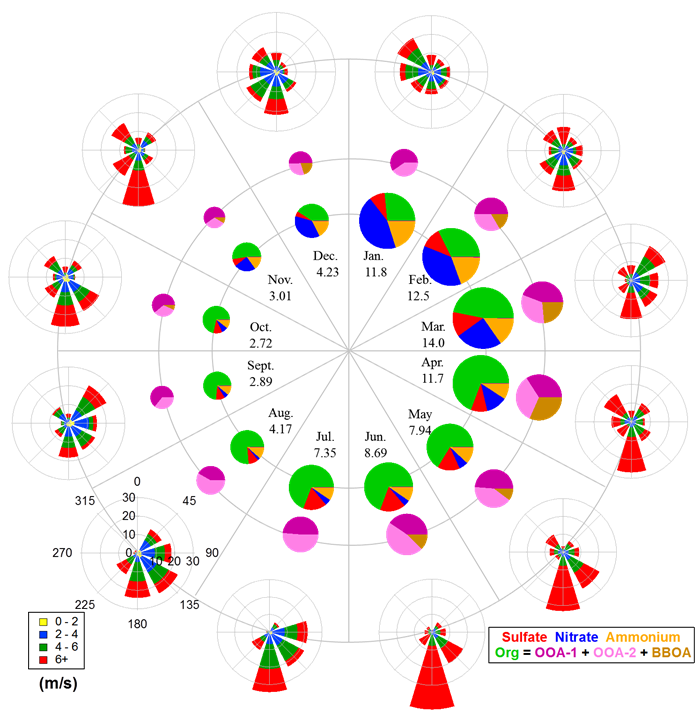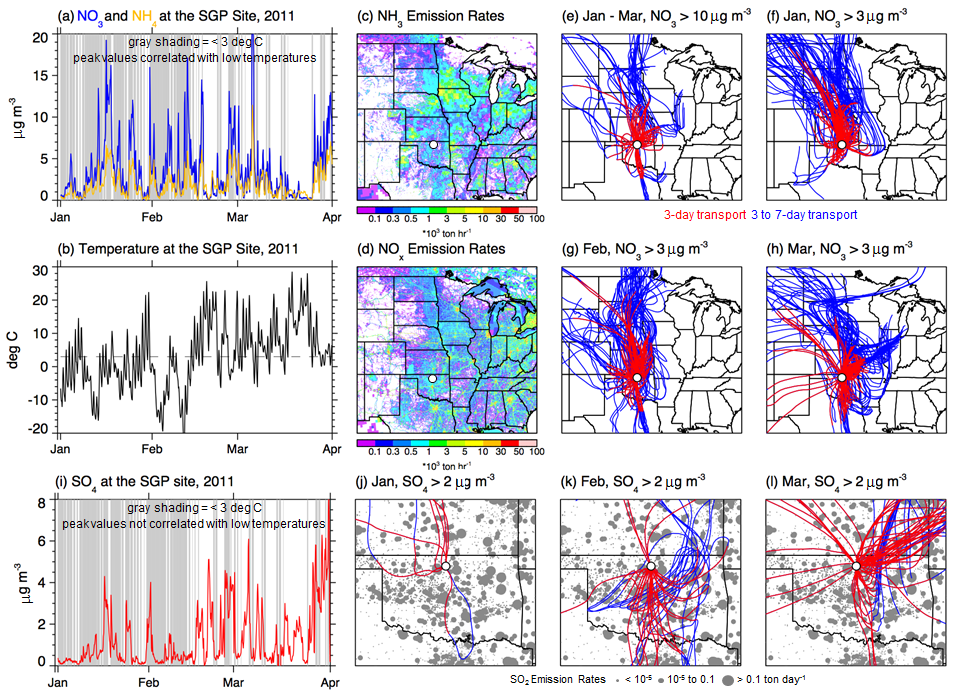Long-Term Measurements of Submicrometer Aerosol Chemistry at SGP Using an ACSM
Submitter:
Zhang, Qi — University of California, Davis
Fast, Jerome D — Pacific Northwest National Laboratory
Area of research:
Aerosol Processes
Journal Reference:
Science
Aerosols are one of the greatest sources of uncertainty in radiative forcing climate model predictions. Co-located measurements of meteorology, radiation, and aerosols are needed to evaluate and improve treatments of aerosol processes in climate models. Measurements characterizing the chemical and physical properties of aerosols are particularly important for understanding sources and processes of aerosols in the atmosphere, and can also be used to predict aerosol optical and hygroscopic properties. At the ARM Southern Great Plains (SGP) site, various instruments have been deployed over the years to measure aerosol size distribution and hygroscopicity. While daily filter samples of aerosols were collected between 2000 and 2008, more detailed and routine measurements of aerosol composition were not available until recently. An Aerosol Chemical Speciation Monitor (ACSM) has been deployed at the SGP Central Facility since late 2010 to measure temporal variations in non-refractory submicron particulate matter (NR-PM1) including organic aerosol (OA), sulfate (SO42-), nitrate (NO3-), ammonium (NH4+), and chloride (Cl-).
Impact
In this study, the long-term trends of NR-PM1 composition and mass concentration measured by an ACSM at the SGP are discussed. NR-PM1 data was recorded at ~30 minute intervals over a period of 19 months between November 2010 and June 2012. Organic compounds were an important aerosol component all year round. In order to capture the dynamic variations of chemical composition and concentration in distinct OA components over time, an Organic Aerosol Component (OACOMP) Value-Added Product (VAP) was developed, allowing Positive Matrix Factorization (PMF) to be performed on long-term ACSM data using a rolling window technique. For the first time, PMF analysis using the OACOMP VAP was performed to determine distinct OA factors, which consist of biomass burning OA (BBOA) and two types of oxygenated OA (OOA) differing in degrees of oxidation. Back trajectory analyses were performed to investigate possible sources of major NR-PM1 species at SGP. Organics dominated NR-PM1 mass concentration for the majority of the study with the exception of winter, when ammonium nitrate increases due to transport of precursor species from surrounding urban and agricultural areas and also due to cooler temperatures. Sulfate mass concentrations have little seasonal variation with mixed regional and local sources. In the spring BBOA emissions increase and are mainly associated with local fires. Isoprene and carbon monoxide emission rates were obtained by the Model of Emissions of Gases and Aerosols from Nature (MEGAN) and the 2011 U.S. National Emissions Inventory to represent the spatial distribution of biogenic and anthropogenic sources, respectively. The combined spatial distribution of isoprene emissions and air mass trajectories suggest that biogenic emissions from the southeast contribute to secondary organic aerosols (SOA) formation at the SGP site during the summer.
Summary
The long-term seasonal, diurnal, weekly, and monthly trends for NR-PM1 mass concentration and composition are summarized for the SGP site. PMF was performed on the measured organic mass spectral matrix using a rolling window technique to derive factors associated with distinct sources, evolution processes, and physiochemical properties. The rolling window approach also allows us to capture the dynamic variations of the chemical properties in OA factors over time. Three OA factors were obtained including two OOAs, differing in degrees of oxidation, and a BBOA. High mass concentration periods of NR-PM1 occur predominantly in the spring and winter months, due to increased emissions of BBOA and formation of ammonium nitrate, respectively. Back trajectory analyses show that BBOA during the spring is mainly from local burning emissions. Cooler ambient temperatures that favor gas-to-particle partitioning and long-range transport of NOx and ammonia from urban and agricultural areas, respectively, resulted in elevated concentrations of ammonium nitrate during the winter. There are no significant seasonal trends in sulfate concentrations and a mixture of local and regional sources are expected for sulfate. For most of the study, organics are aged and highly oxidized, with the exception of biomass burning events.
Long-term and high-time-resolution aerosol mass and composition measurements from this study can be combined with meteorological, radiation, aerosol optical property, and size-distribution measurements from SGP to evaluate aerosol radiative forcing simulations. As this data set continues to expand, it will be useful for observing changes in aerosol composition and concentration over multiple years. The aerosol composition data can also be coupled with other ARM SGP measurements of meteorology, radiation, and aerosol optical and hygroscopic properties to evaluate how well climate models represent the seasonal and multi-year variations in aerosol radiative forcing at this site.



